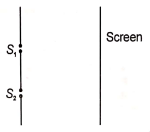At the first minimum adjacent to the central maximum of a single slit diffraction pattern, the phase difference between the Huygen’s wavelet from the edge of the slit and the wavelet from the midpoint of the slit is:
1. \(\frac{\pi}{4}~\text{radian}\)
2. \(\frac{\pi}{2}~\text{radian}\)
3. \(\pi~\text{radian}\)
4. \(\frac{\pi}{8}~\text{radian}\)

To unlock all the explanations of 14 chapters you need to be enrolled in MasterClass Course.

To unlock all the explanations of 14 chapters you need to be enrolled in MasterClass Course.

To unlock all the explanations of 14 chapters you need to be enrolled in MasterClass Course.

To unlock all the explanations of 14 chapters you need to be enrolled in MasterClass Course.
| 1. | \(0.2~\text{mm}\) | 2. | \(0.1~\text{mm}\) |
| 3. | \(0.5~\text{mm}\) | 4. | \(0.02~\text{mm}\) |

To unlock all the explanations of 14 chapters you need to be enrolled in MasterClass Course.

To unlock all the explanations of 14 chapters you need to be enrolled in MasterClass Course.
A beam of light of λ = 600 nm from a distant source falls on a single slit 1 mm wide and the resulting diffraction pattern is observed on a screen 2 m away. The distance between the first dark fringes on either side of the central bright fringe is :
1. 1.2 cm
2. 1.2 mm
3. 2.4 cm
4. 2.4 mm

To unlock all the explanations of 14 chapters you need to be enrolled in MasterClass Course.

To unlock all the explanations of 14 chapters you need to be enrolled in MasterClass Course.
In Young's double-slit experiment, the intensity of light at a point on the screen where the path difference is \(\lambda\) is \(K\), (\(\lambda\) being the wavelength of light used). The intensity at a point where the path difference is \(\frac{\lambda}{4}\) will be:
1. \(K\)
2. \(\frac{K}{4}\)
3. \(\frac{K}{2}\)
4. zero

To unlock all the explanations of 14 chapters you need to be enrolled in MasterClass Course.

To unlock all the explanations of 14 chapters you need to be enrolled in MasterClass Course.
2. 4 mm
3. 3 mm
4. 8 mm

To unlock all the explanations of 14 chapters you need to be enrolled in MasterClass Course.

To unlock all the explanations of 14 chapters you need to be enrolled in MasterClass Course.
A parallel beam of fast-moving electrons is incident normally on a narrow slit. A fluorescent screen is placed at a large distance from the slit. If the speed of the electrons is increased, which of the following statements is correct?
| 1. | The angular width of the central maximum of the diffraction pattern will increase. |
| 2. | The angular width of the central maximum will decrease. |
| 3. | The angular width of the central maximum will be unaffected. |
| 4. | A diffraction pattern is not observed on the screen in the case of electrons. |

To unlock all the explanations of 14 chapters you need to be enrolled in MasterClass Course.

To unlock all the explanations of 14 chapters you need to be enrolled in MasterClass Course.
Which colour of light has the longest wavelength?
1. violet
2. red
3. blue
4. green

To unlock all the explanations of 14 chapters you need to be enrolled in MasterClass Course.

To unlock all the explanations of 14 chapters you need to be enrolled in MasterClass Course.
In a double-slit experiment, when light of wavelength 400 nm was used, the angular width of the first minima formed on a screen placed 1 m away, was found to be 0.2. What will be the angular width of the first minima, if the entire experimental apparatus is immersed in water?
1. 0.1
2. 0.266
3. 0.15
4. 0.05

To unlock all the explanations of 14 chapters you need to be enrolled in MasterClass Course.

To unlock all the explanations of 14 chapters you need to be enrolled in MasterClass Course.
In YDSE like an experiment, the intensity of light from both slits is the same and the interference pattern is observed along a screen parallel to the plane of and . If D, B, A represents the location of a minimum, a maximum, and a point where intensity is the average intensity and is the fringe width and DB, BA, and DA represent the minimum separations, then DB, BA, and DA are:

1.
2.
3.
4.






